Essential oil blending charts streamline your perfume-making journey through visual guides like the Fragrance Family Wheel and Compatibility Matrix. You'll discover foolproof combinations using seasonal scent pairings, base-heart-top note ratios, and mood-based fragrance mapping. Natural vs synthetic mixing charts help balance intensity levels, while concentration guides guarantee proper dilution. Custom signature scent blueprints and layering technique references release your creative potential. The art of masterful fragrance blending awaits your exploration.
Essential Oil Blending Wheel Fundamentals
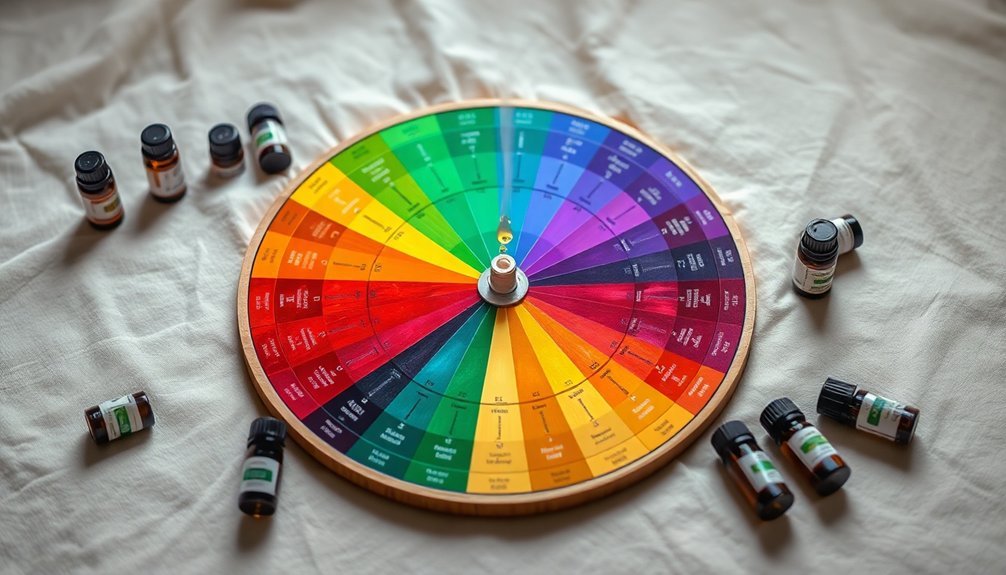
When you're starting your journey into perfume blending, the Essential Oil Blending Wheel serves as your visual compass for creating harmonious scent combinations. This Essential Oil Chart divides fragrances into six distinct families: floral, herbaceous, citrus, woodsy, earthy, and spice.
You'll find that blending scents from adjacent families typically yields the most pleasing results, while diagonal combinations might create less balanced fragrances.
The wheel isn't just about creating beautiful aromas; it's also a guide for Essential Oil Uses in aromatherapy and wellness. You'll discover that each oil brings unique properties that can enhance your mood and well-being.
While the wheel provides reliable guidelines, don't be afraid to experiment beyond its basic principles to create your own signature blends that reflect your personal preferences.
Fragrance Family Compatibility Matrix
When you're exploring fragrance combinations, you'll find that the Fragrance Family Compatibility Matrix offers clear guidance on core scent pairing rules between major fragrance groups like floral, woody, oriental, and fresh.
You can create harmonious blends by matching adjacent scent families on the matrix, while avoiding combinations from opposing groups that might clash.
To achieve a balanced fragrance, you'll need to contemplate the intensity levels of your chosen scents, ensuring that stronger notes don't overpower more subtle ones in your final blend.
Core Scent Pairing Rules
Successful perfume blending relies heavily on understanding the Fragrance Family Compatibility Matrix, a fundamental guide that maps how different scent families interact with each other.
As you explore the matrix, you'll find that adjacent scent families, such as floral and fruity, create the most harmonious blend combinations due to their natural compatibility.
When working with opposite scent families, like oriental and fresh, you'll need to carefully balance their proportions to achieve a unique yet pleasing fragrance.
It's best to avoid diagonal combinations in the matrix, as these scents typically clash. However, don't let this discourage your experimentation – understanding these core pairing rules empowers you to create signature fragrances while minimizing the risk of unfavorable combinations.
Matching Compatible Scent Groups
While the art of perfume blending allows for creative freedom, the Fragrance Family Compatibility Matrix serves as your essential roadmap for creating harmonious scent combinations.
You'll find that adjacent scent families naturally complement each other, offering opportunities for compatible blends that delight the senses.
When working with the matrix, keep these key principles in mind:
- Start with adjacent families, like floral and fruity, for foolproof fragrance combinations
- Experiment with opposite families to create bold, contrasting statements
- Use the matrix as a guide, but don't be afraid to trust your instincts
- Consider how different scent families interact before finalizing your blend
Intensity Level Balancing
Understanding the intensity levels of different fragrance families stands as an essential step in creating well-balanced perfume blends. When you're blending fragrances, you'll need to take into account how strong each note will be in your final composition.
| Intensity | Top Notes | Base Notes |
|---|---|---|
| Light | Citrus | Musk |
| Medium | Floral | Woody |
| Strong | Spice | Oriental |
The Intensity Level Balancing chart helps you identify which fragrance families work harmoniously together. You'll find that adjacent families on the chart typically blend more smoothly, creating natural shifts in your perfume. For the best results, experiment with varying intensity levels within compatible groups. This approach not only enhances your blend's longevity but also guarantees proper projection throughout the wearing experience.
Seasonal Scent Pairing Guide
You'll find that altering your fragrances between summer and winter requires thoughtful adjustments, shifting from light, tropical notes to deeper, warming scents as temperatures drop.
When layering fragrances for warmer weather, opt for fresh combinations like coconut with sea salt or cucumber with citrus to create an airy, revitalizing effect.
For colder conditions, you can build rich, dimensional scents by combining sweet notes like vanilla or caramel with spicy undertones of cinnamon or clove to maintain warmth and depth.
Summer-Winter Fragrance Transitions
As seasons shift from warm to cool, your fragrance choices can elegantly evolve to match nature's changing moods. Understanding fragrance families helps you blend well together your favorite summer and winter scents from the Essential Top 16 Oils collection.
You'll create sophisticated combinations that work year-round.
Make your seasonal change smooth with these proven techniques:
- Layer light citrus notes with warm vanilla or musk base notes
- Combine fresh florals with spicy orientals for depth
- Mix bright summer fruits with rich winter woods
- Pair your signature summer scent with deeper aromatics
Don't be afraid to experiment with unique combinations – your personal preference matters most.
Layering By Weather Type
The art of layering fragrances shifts dramatically with changing weather patterns, requiring thoughtful adjustments to your scent combinations.
During warm weather, you'll want to start with light citrus bases and build up to delicate floral notes. These layering techniques create invigorating blends that won't feel overwhelming in the heat.
As temperatures drop, change to richer seasonal scent pairings. Begin with warm amber or vanilla bases, then layer spicy notes on top for depth and complexity.
You'll find that crisp, clean fragrances work particularly well in cool weather, while sweet, fruity combinations shine in warmer months.
Don't hesitate to experiment with different fragrance combinations across seasons. Start with simple two-note blends and gradually explore more complex layering as you discover which scents best reflect your style in each weather condition.
Base, Heart, and Top Note Combinations
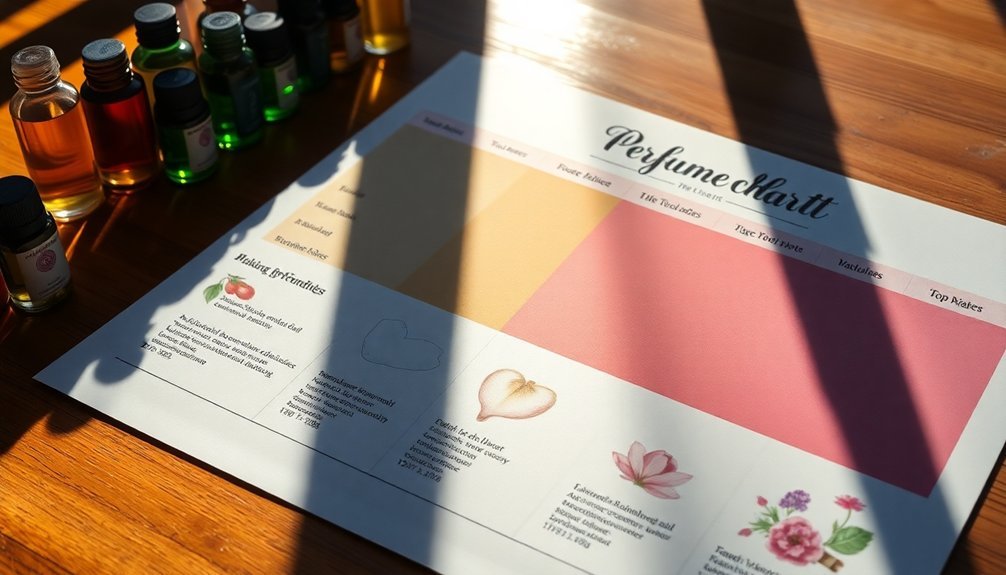
Creating successful perfume combinations requires understanding how base, heart, and top notes interact to form a complete fragrance story.
When you're blending your own signature scent, start with your base notes as the foundation, then build upward through the layers for a well-structured fragrance.
- Select your base notes first (like vanilla, musk, or woody scents) to establish your fragrance's lasting foundation.
- Layer in your heart notes (such as florals or fruit scents) to create the perfume's main character.
- Add top notes (typically citrus or fresh scents) last to create an engaging initial impression.
- Use a blending chart to identify which scents complement each other within each note category.
This structured approach guarantees you'll create harmonious combinations that evolve beautifully throughout the day.
Natural Vs Synthetic Scent Mixing Chart
When mixing natural and synthetic scents, you'll need to take into account that synthetic fragrances offer greater stability and longer shelf life, while natural ones may require more frequent replacement due to degradation.
You can gauge scent intensity by testing synthetic fragrances at half the concentration of natural ones, as synthetic scents often project more strongly and last longer on the skin.
Your blending success depends on following proper mixing ratios, where natural essential oils typically blend at 2-3% concentration while synthetic fragrances work effectively at 1-2% in your carrier base.
Stability Vs Shelf Life
Understanding stability and shelf life differences between natural and synthetic fragrances helps you make informed blending decisions for your perfumes.
When you're working with essential oils, you'll need to take into account their shorter shelf life of 1-3 years compared to synthetic fragrances that can last 5+ years.
To maximize the longevity of your blends, keep these key factors in mind:
- Natural citrus oils deteriorate faster than base notes like vanilla or cedarwood.
- Essential oils oxidize more quickly, affecting their original scent profile.
- Synthetic fragrances offer greater stability and predictable aging.
- Proper storage away from light and heat extends the life of both types.
When blending natural and synthetic scents, plan your ratios carefully to account for the natural components' shorter lifespan and higher volatility.
Scent Intensity Comparisons
Since natural and synthetic fragrances exhibit different intensity levels, you'll need a reliable mixing chart to achieve balanced blends.
When consulting your Essential Oil Reference Guide, you'll notice that natural scents often project softer, more nuanced notes compared to their synthetic counterparts.
Your blending ideas should account for these intensity variations. Natural fragrances typically require higher concentrations to match the strength of synthetic scents, which tend to maintain consistent potency.
Start by testing different ratios – you might find that a 2:1 natural-to-synthetic ratio creates the perfect balance.
Remember that scent intensity comparisons aren't just about strength; they're about creating harmony between the complex depth of natural ingredients and the lasting power of synthetic components.
Use your mixing chart to document successful combinations and adjust proportions until you achieve your desired fragrance profile.
Blending Properties Guide
The key distinctions between natural and synthetic scents form the foundation of any successful blending properties guide.
When you're creating fragrances, understanding how these elements interact will guarantee your combinations work harmoniously.
Natural scents, particularly essential oils, offer complex aromatic profiles that you'll need to balance carefully with synthetic components.
To master this art, focus on these vital aspects:
- Check the solubility of your ingredients – oil-based naturals won't mix well with water-based synthetics
- Study evaporation rates to predict how your fragrance will evolve over time
- Reference compatible scent families to identify complementary natural-synthetic pairs
- Consider stability factors, as natural components may be less consistent than synthetic ones
This structured approach to blending properties will help you create balanced, long-lasting fragrances that combine the best of both worlds.
Aromatherapy Blending Proportions
Creating effective aromatherapy blends relies on a precise balance of essential oil proportions: 30% top notes, 50% middle notes, and 20% base notes. You'll find this standard formula creates harmonious fragrances that deliver ideal therapeutic benefits.
When you're ready to blend your essential oils, start with just a few drops of each component. You can adjust the mix gradually until you achieve your desired scent profile.
For skin applications, stick to a 2-3% dilution ratio – that's about 12-18 drops per ounce of carrier oil. To guarantee you're combining compatible scents, consult a blending chart that maps out complementary fragrance families.
Don't be afraid to experiment with your proportions. While these guidelines provide a solid foundation, your personal preferences will ultimately determine the perfect blend for you.
Mood-Based Fragrance Mapping
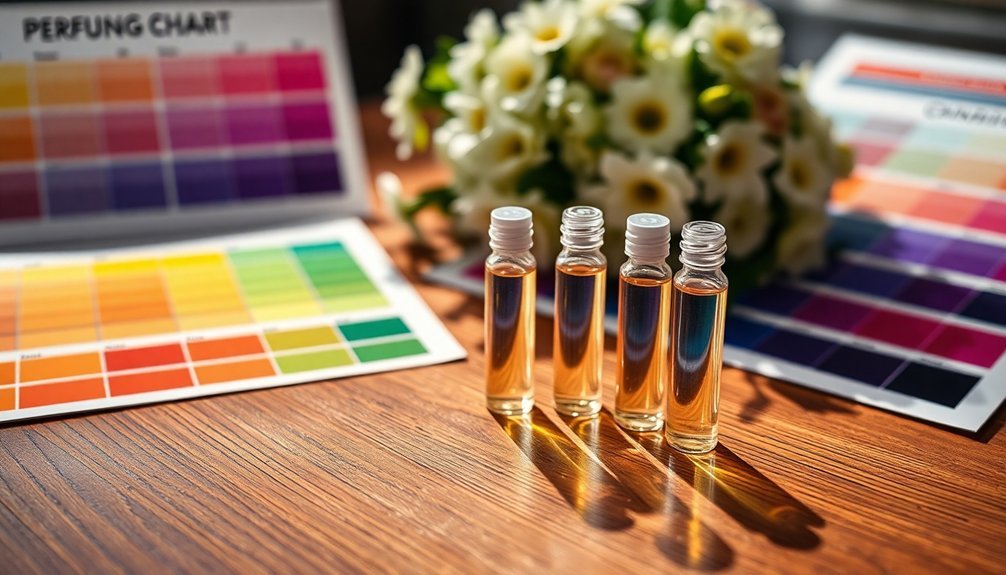
Understanding your emotional state plays an essential role in selecting the perfect fragrance blend. When you practice mood-based fragrance mapping, you'll connect with scents that truly resonate with your desired emotional state.
You can blend scents strategically through fragrance layering to create a personalized aromatic journey that evolves throughout the day.
- Start with citrus or fresh notes to energize your morning routine
- Layer in floral heart notes to maintain emotional balance mid-day
- Add earthy base notes for grounding when you need stability
- Adjust your combinations seasonally – lighter blends for spring/summer liveliness, warmer notes for fall/winter comfort
Use a mood-based chart to identify which scent families align with your emotional goals, ensuring your fragrance choices support your well-being throughout different situations and seasons.
Perfume Concentration Ratios
When developing your signature fragrance blend, mastering perfume concentration ratios becomes essential for achieving the ideal balance and longevity. You'll find that successful blending depends on understanding how different concentrations interact to create harmonious fragrance combinations.
| Concentration Type | Ratio Range | Lasting Power |
|---|---|---|
| Parfum | 20-30% | 6-8 hours |
| Eau de Parfum | 15-20% | 4-6 hours |
| Eau de Toilette | 5-15% | 2-4 hours |
| Eau de Cologne | 2-5% | 1-2 hours |
For best results, structure your blend using the 30-50-20 rule: 30% base notes, 50% heart notes, and 20% top notes. You can adjust these ratios to match your preferences, experimenting with higher concentrations for deeper, longer-lasting scents or lower ones for lighter, fresher alternatives.
Custom Signature Scent Blueprint
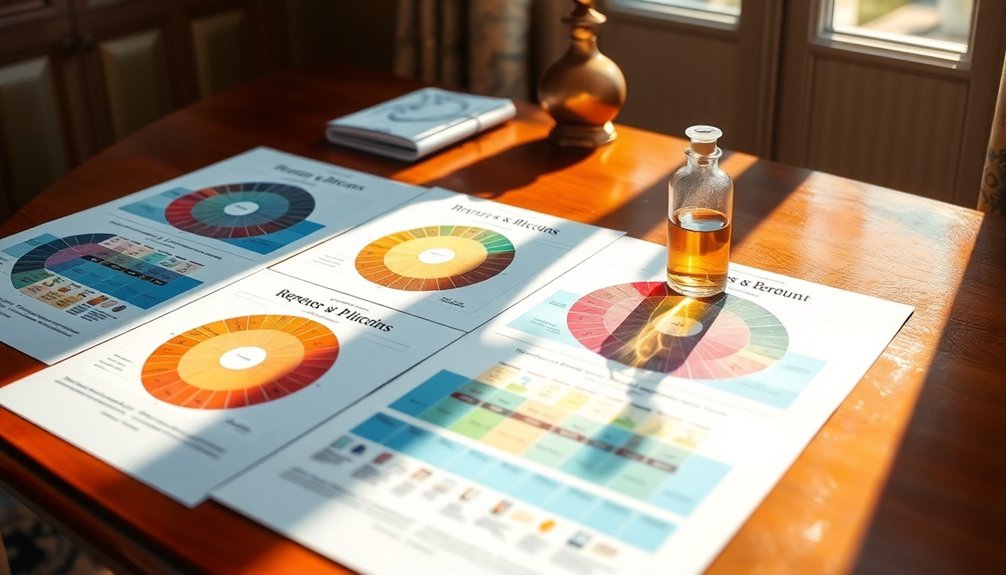
To develop your signature scent blueprint, you'll need to thoughtfully select and combine complementary fragrance notes that reflect your personal style.
Using a blending chart will help you identify which essential oils work harmoniously together, creating a balanced custom signature scent that's uniquely yours.
Follow these steps to craft your perfect fragrance:
- Select your base note as the foundation, choosing from rich scents like vanilla, sandalwood, or musk.
- Add a heart note that bridges your top and base notes, such as lavender, rose, or jasmine.
- Top it off with lighter, fresh scents like citrus or herbs that create an initial impression.
- Test small batches and document your ratios for consistent results.
Remember to take into account seasonal changes and emotional connections when refining your signature blend.
Layering Technique Reference Chart
The layering technique reference chart serves as your essential roadmap for creating multi-dimensional fragrances.
You'll find a clear breakdown of base, heart, and top notes that guides you through the blending process step by step.
Start your fragrance composition with light top notes like citrus or aromatics to establish that initial fresh impression.
Next, you'll layer in heart notes, incorporating floral or fruity elements that form the scent's core character.
Finally, add rich base notes such as vanilla or musk to anchor your creation.
The chart's suggested blending ideas help you experiment confidently, showing which scents work harmoniously together – like pairing florals with woody notes or citrus with spicy elements.
Frequently Asked Questions
What Fragrance Blends Well Together?
You'll find that floral scents blend beautifully with woody notes, while citrus pairs well with spices. Don't forget to layer your fragrances with base, heart, and top notes for best results.
What Is the 30/50/20 Rule for Perfume?
The 30/50/20 rule means you'll blend your perfume using 30% base notes for longevity, 50% heart notes for the main character, and 20% top notes for the initial impression of your fragrance.
What Is the Ratio for Blending Perfume?
You'll want to follow the standard 30/50/20 ratio when blending perfume: 30% top notes, 50% heart notes, and 20% base notes. For skin-safe application, dilute with 80% carrier oil.
What Fragrances Pair Well Together?
You'll find that floral scents pair beautifully with woody notes, while citrus works well with spicy fragrances. Oriental blends complement vanilla and amber, and fresh scents mix nicely with light florals and herbs.
In Summary
You've now got the essential tools to create amazing fragrance combinations with confidence. Whether you're blending essential oils, mixing synthetic scents, or layering your favorite perfumes, these 10 charts serve as your roadmap to success. Start experimenting with different ratios and pairings, trust your nose, and don't be afraid to break conventional rules. Your perfect signature scent is waiting to be discovered.
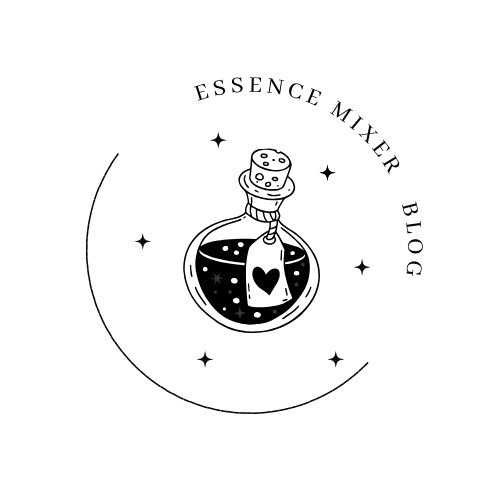
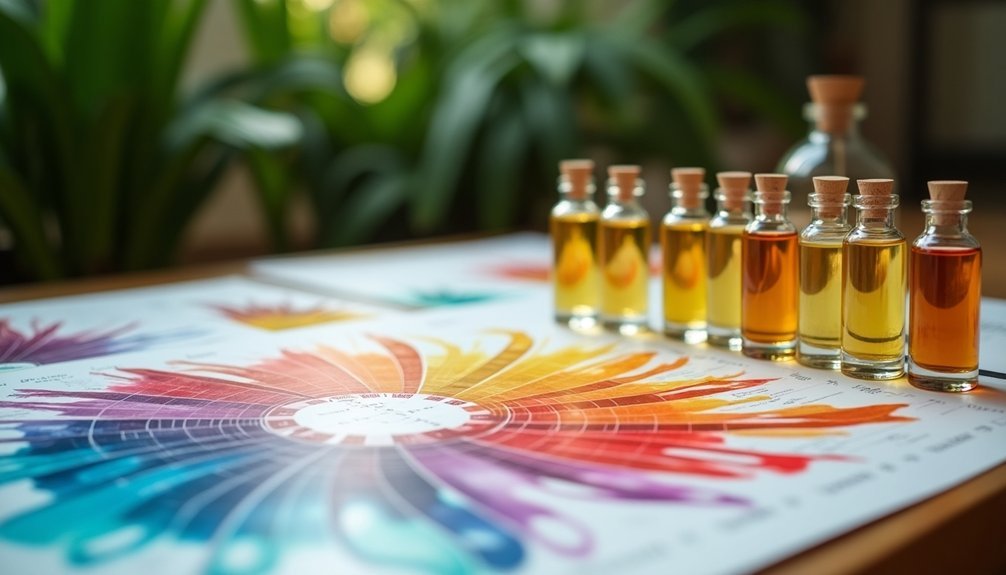



Leave a Reply